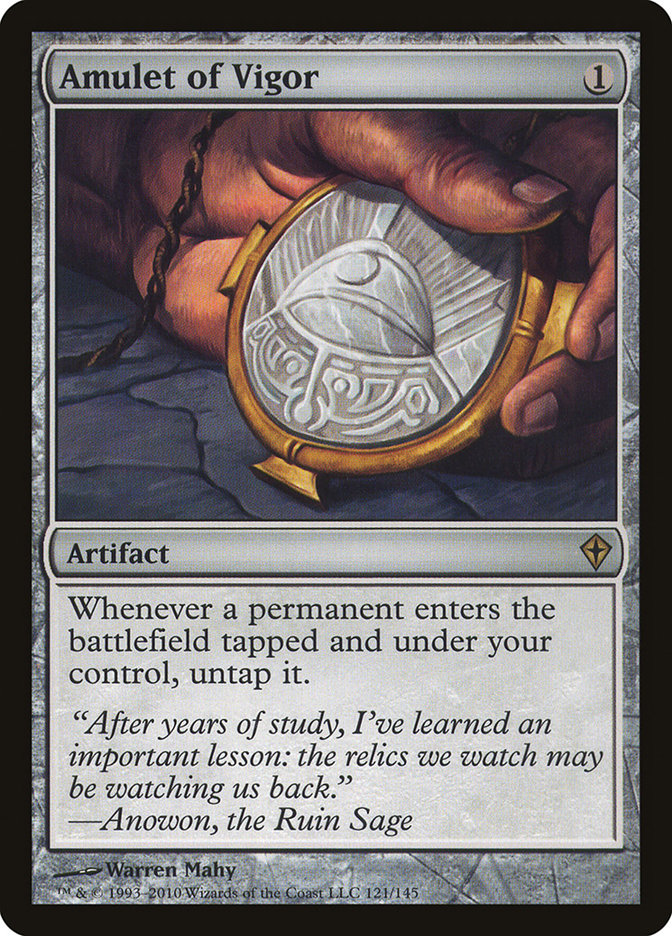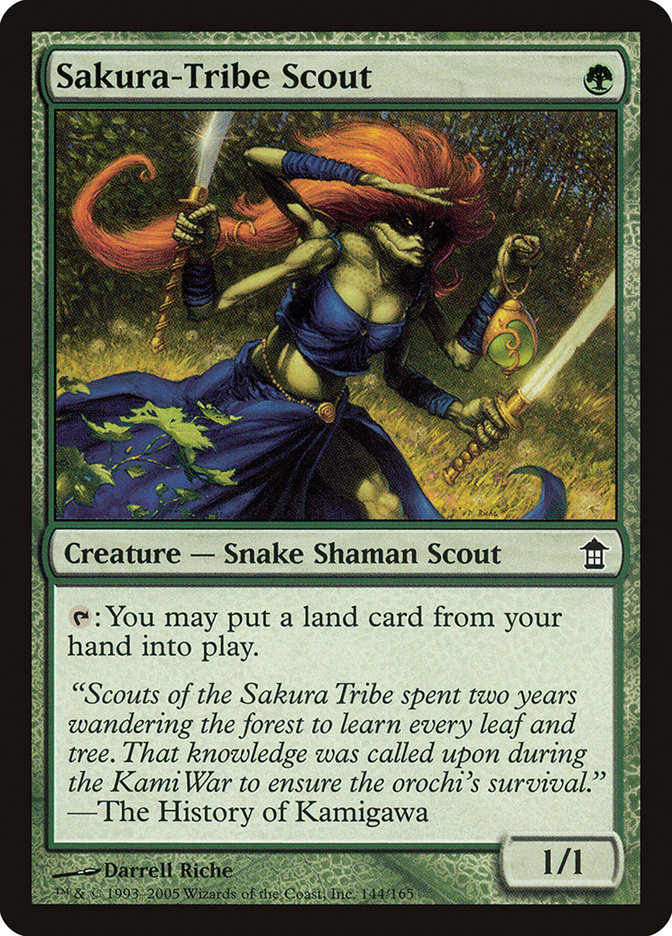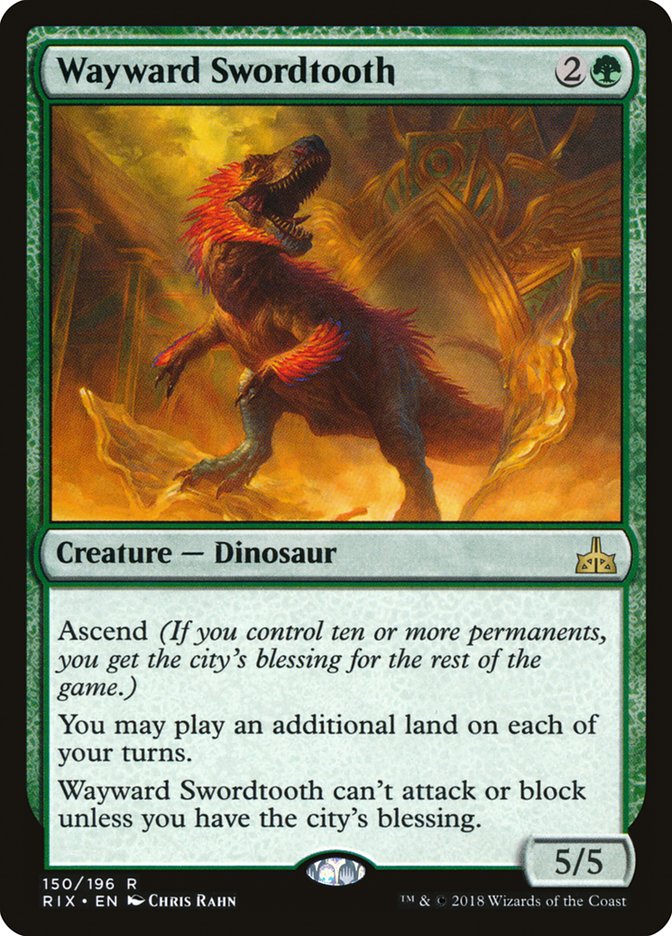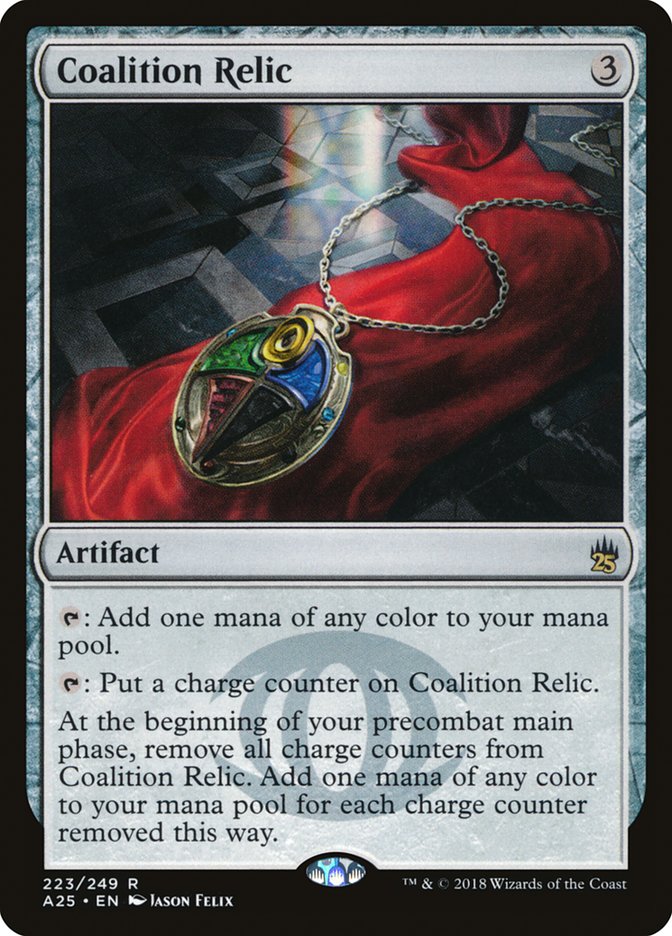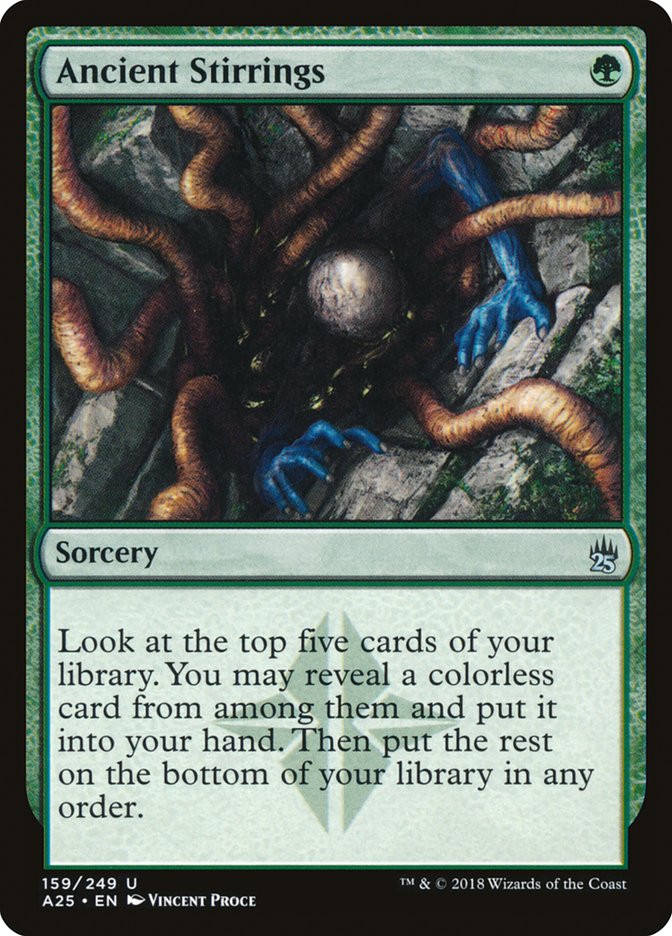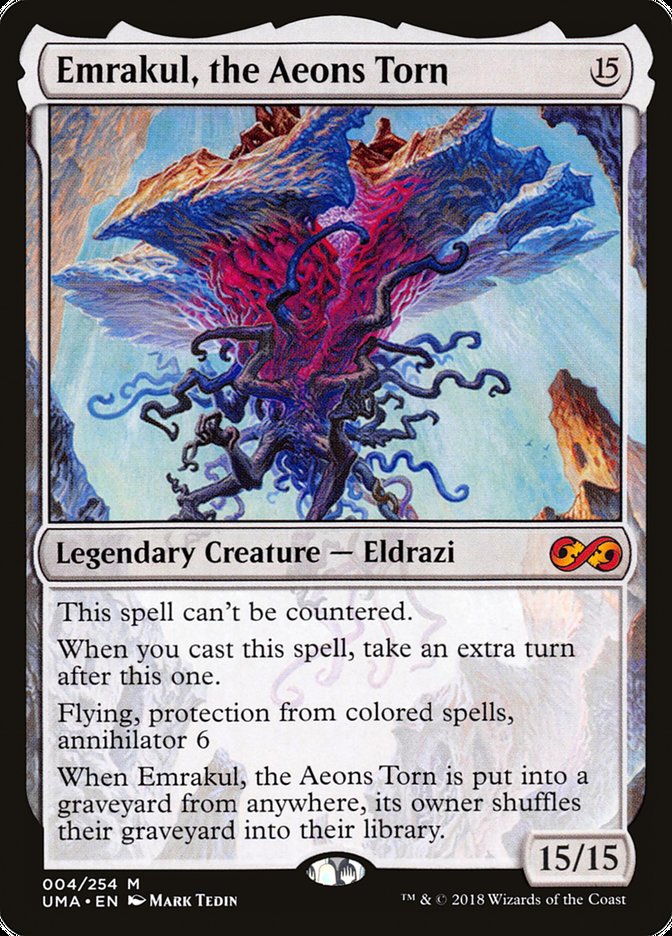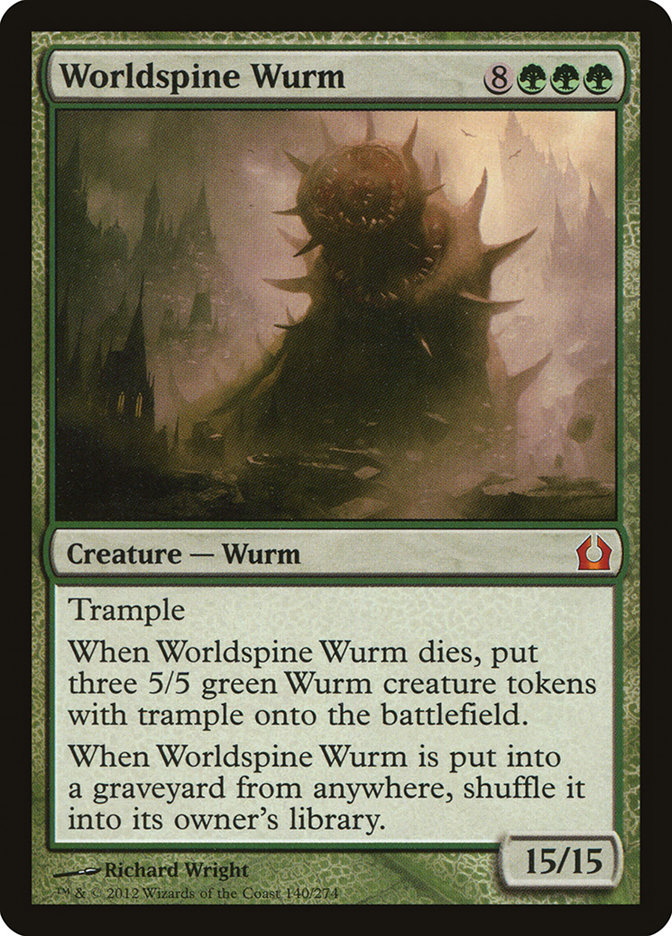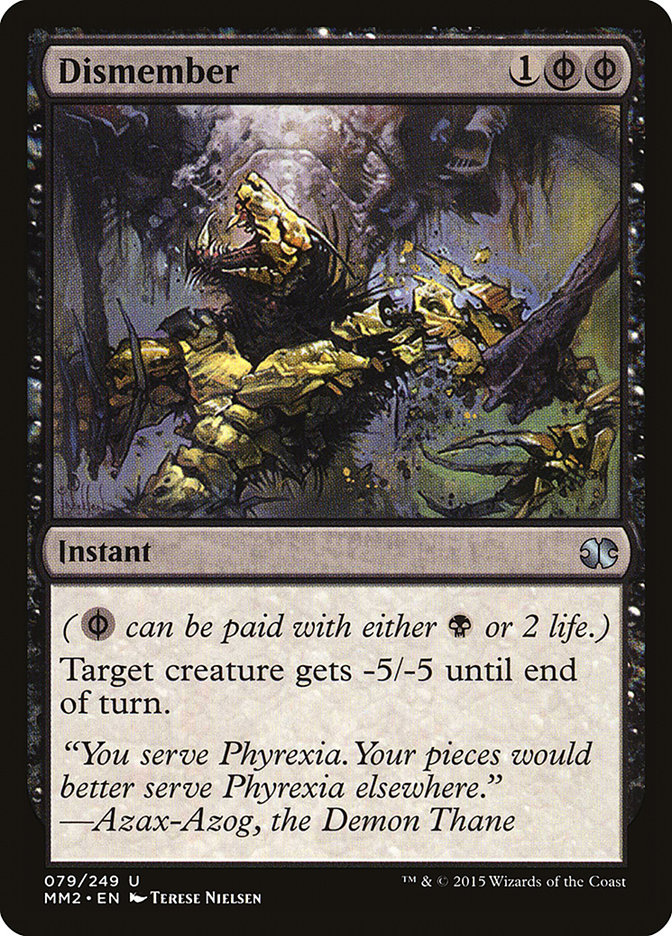“I have no idea what’s going on.”
Those words came from Abe Stein in my first game of the tournament but were
echoed by opponents, commentators, and viewers alike over the weekend.
During my wild ride towards the finals, I began to utter them myself.
“Did I break it? Was this all a joke? Have I created a monster I can’t
control?”
The truth is more mundane. Amulet Titan, a deck I’ve known and loved since
the days of Summer Bloom, was well-positioned for the weekend. The matchups
and situations I encountered gave the unique features of my build a chance
to shine. Like everyone who wins a tournament, I had my share of good luck;
and in Worcester, fortune favored the bold.
Wayward Swordtooth may not be here to stay in Modern, but Amulet Titan
certainly is. I hope my thoughts will encourage you to leap through the
breach or at least to understand why I did.
Creatures (13)
Lands (28)
Spells (19)

Although I built this list in Jonathan Rosum’s basement hours before the
tournament, my first fling with the idea came years ago. In preparing for
Pro Tour Oath of the Gatewatch, I wanted a replacement for the
Summer Blooms that got me there, trying Through the Breach and other failed
experiments. Some of the new builds back then were promising, but none
seemed strong enough to commit to for a Pro Tour. Eventually, I admitted
defeat and gave up Amulet of Vigor for Arcbound Ravager.
The top priority here was to compensate for the speed lost without Summer
Bloom. A major strength of Amulet Titan is its inherent strength against
any attrition strategy. Anyone who has played with the Ravnica
bouncelands in Limited can attest to the power of the “free” mana in longer
games, and these are already priced in to Amulet Titan’s manabase. Primeval
Titan is Squadron Hawk meets Rune-Scarred Demon with a touch of Thragtusk.
Meanwhile, the deck features several intersecting toolboxes that ensure the
right silver bullet will be in the chamber eventually. With enough time,
Amulet Titan can and will create an overwhelming cascade of card advantage
and find the perfect tools to lock up the game.
That sounds appealing, so why aren’t more people playing bouncelands and
six-drops in Modern? Anyone who tried would be swiftly cut down by a volley
of Grapeshots, exiled by Karn Liberated, or fed to the Krark-Clan
Ironworks. Amulet Titan’s ability to keep pace with the degenerate decks of
Modern is what keeps it viable; the threat of a quick combo kill distorts
your opponents’ sequencing and sideboarding in a way that helps you even
further in grindy games and places a floor on how bad any matchup can be.
Amulet Titan is generally, and understandably, viewed as a combo deck with
uncommon lategame potential, but it can help to think of it as a toolbox or
ramp deck that’s capable of early wins. The sleek and efficient Turn 3
kills enable the elaborate nonsense behind the Turn 10 kills, and vice
versa.
This balance should inform how you build and play the deck; less
experienced Amulet Titan pilots fill their lists with more clunky threats
like Zacama, Primal Calamity that don’t serve a clear purpose, or shave
copies of crucial enablers like Azusa, Lost but Seeking. The inclusion of
Through the Breach is a way to maintain this balance while adding new
angles of attack.
Without its first namesake card, the best Amulet Titan can do by Turn 4 is
tap out for its second Primeval Titan. If immediate access to a land like
Bojuka Bog will win the game, this may be enough; otherwise, you need to
mulligan aggressively for Amulet of Vigor to keep up. This requires tipping
your hand by exposing Amulet and also leaves you vulnerable to cards like
Engineered Explosives or Nature’s Claim. Through the Breach into Emrakul,
the Aeons Torn gives you a fast way to shut the door in games where you
don’t already have your best card.
Breach also makes your Amulet draws even more explosive. Previous lists
featured Spinerock Knoll to hopefully turn a Titan attack into a permanent
Emrakul, but this still took at least one Teetering Peaks to reach the
damage threshold for Knoll and required a complete overhaul of the
manabase. The realization that Teetering Peaks sets up a lethal damage line
by itself while fitting seamlessly into the deck’s existing structure
justified committing to Through the Breach:
-
Through the Breach lets Primeval Titan enter the battlefield with
haste. -
The enters-the-battlefield trigger fetches Teetering Peaks and
Sunhome, Fortress of the Legion (Primeval Titan is now 8/6). -
The attack trigger fetches Vesuva, copying Teetering Peaks, and
either Boros Garrison or Crumbling Vestige (Primeval Titan is now
10/6). -
You now have exactly enough mana (2RRW or 2CRW) to activate Sunhome
for exactly twenty damage.
Breach costing five mana also makes the setup with Amulet much easier.
Azusa, Lost but Seeking only nets one mana on the turn it arrives if you
have Amulet and a bounceland (the two additional land drops make two mana
each, and Azusa costs three). Unless you can follow up Turn 1 Amulet with
Turn 2 Azusa, reaching six mana requires Azusa living through Turn 4; by
that point, most decks have already deployed threats and can hold up
removal. Only needing five mana instead for Through the Breach may seem
like a small change, but it can make all the difference. If your opponent
doesn’t know what you can do with five mana, you can steal games when they
tap out to develop their battlefield; if they do know, their uncertainty
over the texture of your hand can cause them to play too conservatively,
allowing the game to last longer and your lategame superiority to kick in.
Breach being in the deck makes Azusa – and, by extension, Summoner’s Pact –
that much better.
Amulet Titan is typically favored against control decks, as Cavern of Souls
or Pact of Negation can start a chain of Primeval Titans which puts the
game out of reach. One problem with this plan is its reliance on expensive
sorcery-speed threats, exploitable by smart opponents who know to take
aggressive lines with Snapcaster Mage to end the game quickly. Through the
Breach gives you a slightly cheaper, instant-speed threat that can test the
waters in their end step and either put a Titan onto the battlefield
directly or clear the way for you to resolve Titan on your turn. Even if
they have a removal spell, Titan’s enters-the-battlefield trigger can find
Tolaria West and a bounceland to keep the chain going; and, if your payoff
for Breach is Emrakul, the game is over.
Finally, Through the Breach offers insurance against Blood Moon. The Izzet
Phoenix matchup is the most important litmus test for a Modern deck right
now, and Blood Moon is a valuable tool for Izzet Phoenix in its tougher
matchups like Amulet Titan or Grixis Death’s Shadow. Blood Moon still shuts
off convoluted Breach into Titan kills, but fetching basic Forests allows
you to cast further threats and stay in an otherwise unwinnable game.
This Breach plan does take up space in the deck and requires certain
sacrifices. However, I believe the main criticism – that it makes the deck
inconsistent – is inaccurate, or at least misleading.
This is the most impressive sample hand I’ve seen in a
while.. pic.twitter.com/xt3OHkarog—
Autumn Burchett (@AutumnLilyMTG) January
15, 2019
Sometimes you open hands like this and wonder what you signed up for, and
it’s frustrating when discard breaks up your combo and leaves a Breach or
Emrakul stranded in your hand. That said, this package fills the open slots
in the deck that were previously used on other ramp spells – whose job I
think Breach does better – and more toolbox components; the main Primeval
Titan plan remains unscathed. When you do face down discard, you now have
additional outs that you can draw at any time to present a threat; it’s the
combination of discard and other disruption, most often found in Death’s
Shadow decks, that beats Breach. Against disruption aimed at cutting off
mana or specific utility lands, Breach makes your deck more consistent as
your goal is lower and Emrakul needs no help to clean up.
In a format as fast and ruthless as Modern, speed also factors into
consistency. It’s very common to lose a game of Modern with several cards
in your hand having made little progress towards your gameplan; it doesn’t
matter how ‘normal’ your hand looks if none of it can save you from your
fate. It’s worth feeling embarrassed about sample hands or helpless against
some forms of counterplay if your overall win rate improves.
After Summer Bloom left the stage, a consensus soon formed that
Sakura-Tribe Scout was the best replacement. Scout enables the fastest
draws in the deck, ramping you past six mana on Turn 3 with Amulet and a
bounceland, and using Scout to save a land from Field of Ruin or Fulminator
Mage with a bounceland or get the effects of Bojuka Bog and Khalni Garden
at a moment’s notice makes you much harder to play against. This comes with
an obvious downside: the likes of Lightning Bolt – borderline useless
against Amulet Bloom in its prime – can now make your draw grind to a halt.
This used to be a minor concern as Scout was unlikely to die in matchups
where the boost in speed was crucial, but decks like Izzet Phoenix or
Hardened Scales can present a formidable clock while whacking your Snakes.
Scout also places tight demands on your manabase as it has highly
diminishing returns after Turn 1, and between the various bouncelands and
utility lands, you only have room for the bare minimum of untapped green
sources.
Wayward Swordtooth auditioned for that slot and passed with flying colors.
Its strength against Burn in particular is appealing right now, but even
against hard removal, you’re guaranteed to get at least one land drop out
of it. Even though the bouncelands work against achieving the city’s
blessing, one Primeval Titan resolving usually gets you there, especially
if you can replay a Khalni Garden. Swordtooth increases your threat density
in longer games and soon becomes a serious problem. I didn’t realize until
I beat Izzet Phoenix on a mulligan to four this way in the tournament that
Swordtooth also makes Through the Breach for Primeval Titan without an
Amulet much better: the enters-the-battlefield trigger gets you enough
permanents to ascend and the combined attack means that the Swordtooth
sticks around as a near-lethal threat after Titan is gone. Several
observers were alarmed by the deck’s top-heavy mana curve without
Sakura-Tribe Scout, but the two cards serve the same purpose — ramping you
towards Primeval Titan — and Scout is only faster if you play it on Turn 1
and find an Amulet on Turn 2, which admittedly is a common role of Ancient
Stirrings.
If I’m happy for my wayward son to carry on, why is there a Coalition
Relic? A common mode of failure for Amulet Titan is drawing a surplus of
ramp effects but not the lands to use with them; Coalition Relic satisfies
the basic requirement of jumping to six mana on Turn 4 by itself while also
fixing your mana for Primeval Titan through Blood Moon and making it easier
to support Tolaria West, Slayers’ Stronghold/Sunhome, Fortress of the
Legion, and sideboard cards across the color pie in your mono-green deck.
Crucially, Relic is another ramp card to find with Ancient Stirrings.
Stirrings in this deck can be the game-changer it is elsewhere, delivering
the Amulet or bounceland you need at the perfect time, or just more of the
same in a hand missing crucial ingredients. The frequent hands with
Stirrings but no ramp would be much more tempting if Stirrings could find
acceleration beyond just Amulet; a single Coalition Relic isn’t enough to
move that needle, but it’s a good start. Although there are only two copies
of Emrakul in the deck, Stirrings finding a colorless combo piece makes
that whole package more stable; I suspect this is part of why recent Amulet
Titan lists lean so hard on Engineered Explosives in their sideboard as
their all-purpose answer of choice. Stirrings is still great even in a ‘bad
Stirrings deck,’ but any improvement is welcome.
Sadly, it’s hard to justify running more Relics as they get caught in the
crossfire aimed at Amulet of Vigor. Amulet accounts for your quickest and
flashiest wins and gives the deck its name, so many opponents reach for
cards like Ancient Grudge and Ceremonious Rejection with too much
enthusiasm. One Relic is the ideal number to exploit its strengths in the
first game while keeping a sufficient density of ramp in the deck if your
artifacts are under attack.
All these card choices are intentional deviations from the stock list, but
‘stock’ has less meaning here than for almost any other archetype. To a new
Modern player, this list would look bizarre and confusing but no more so
than the list that Edgar Magalhaes, Matthew Dilks, and Daryl Ayers all took
to the Top 4 of the Team Modern Open at SCG Columbus. Amulet is
conceptually unique and hard even for its devotees to fully understand, so
there may be more variations with unexplored potential. Even the stock list
has changed dramatically since Will Pulliam won SCG Charlotte a few months
ago, as Edgar and friends swap the sideboard color seemingly every week in
a manner reminiscent of Gerry Thompson’s iteration on Caw-Blade many moons
ago. Not every innovation is guaranteed to succeed, but I’d hope and expect
the Amulet community to keep an open mind.
Here’s where I would begin if I returned to the deck:
Creatures (13)
Lands (28)
Spells (19)

This maindeck is identical to the one I ran in Worcester, and I wouldn’t
deviate much from this starting 60. I often consider switching the second
Emrakul with the sideboard Worldspine Wurm as another high-impact card to
send Through the Breach that can be found by Summoner’s Pact when Primeval
Titan won’t do the job. Worldspine Wurm is weak to common fixtures of
Modern, notably Path to Exile and fliers. Additionally, the main purpose of
Through the Breach is to shift races in your favor by becoming a turn
faster; unless you can expect the first hit for fifteen to be lethal, all
this does is give your Wurm tokens the best seat in the house to whatever
show your opponent puts on. It doesn’t help that many of those decks have
easy access to clean answers for the tokens: Engineered Explosives in
Ironworks and Amulet Titan, or Oblivion Stone and Ugin, the Spirit Dragon
in Tron. It shines in matchups like Dredge, Golgari-based Midrange, and
Burn, but it can go if space is a concern.
Chameleon Colossus returns to the sideboard as Grixis Death’s Shadow is on
the rise again. Dismember steps in for Rending Volley for the same reason,
but also because an interactive card that effectively costs a single
colorless mana is highly valuable in a deck with such a messy manabase.
Firespout felt like a necessary evil against Bant Spirits, but Edgar
Magalhaes and his team were confident in the Spirits matchup with their
shell, and emulating them with Trinket Mages and more Walking Ballistas or
Engineered Explosives may be a better approach as it lets you mimic their
configuration where those lists are better and get the best of both worlds.
My justification for Courser of Kruphix was that it was the best card for
grinding out midrange or control decks as it stops them from going
underneath you while keeping a steady flow of lands to let you cast your
more expensive threats. It also pulls its weight against decks like Dredge
and Burn that put pressure on your life total. With extra Exploration
effects in Wayward Swordtooth, Courser lets you churn through your library
at an alarming rate.
VS Ironworks
Out:
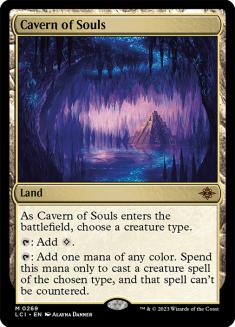

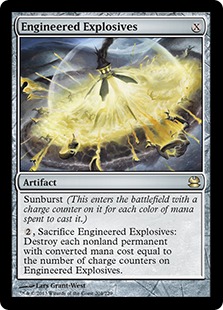


In:
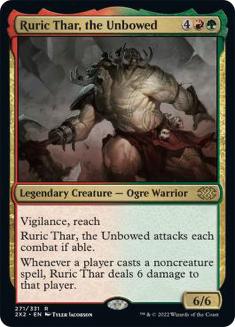


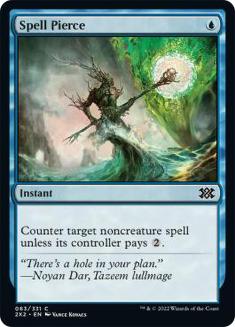

Ironworks’ median goldfish is still faster than yours, but Breach gives you
a good shot in Game 1, and you improve more than they do in sideboarding. A
skilled Ironworks player can shrug off Abrade and Relic of Progenitus
unless you have other ways to poke a hole in their draw, and diluting your
deck with weak reactive cards gives the opponent more time and tools to
play around them.
Out:
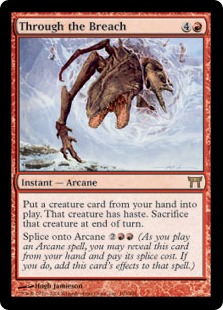



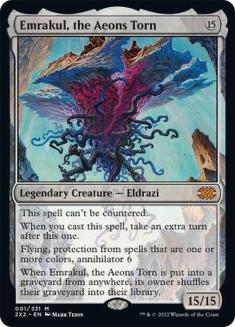

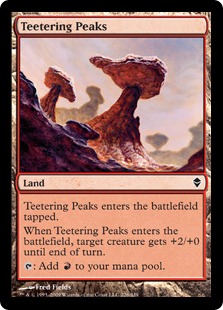

In:
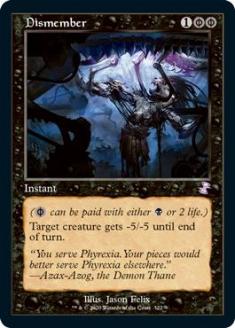

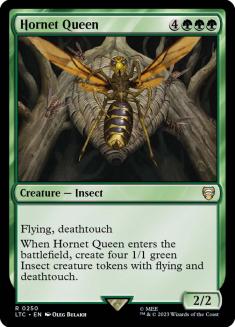
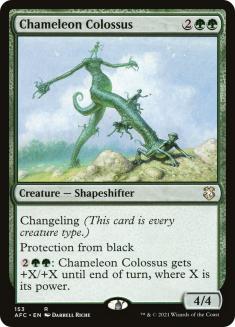
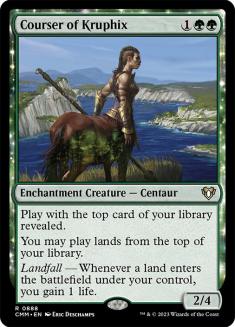
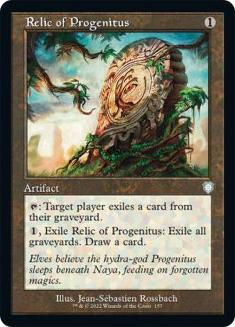


This is the matchup that suffers most from the move to Through the Breach,
and the decision over which version to play will depend heavily on how much
Shadow you expect to face. Cutting a land with no application in the
matchup is a common sideboarding tactic; note that Teetering Peaks can be
that land when Through the Breach leaves the deck. Pact of Negation is weak
against discard and will often burn a hole in your hand, but some draws
will struggle to beat Stubborn Denial or Disdainful Stroke without it.
VS Bant Spirits
Out:







In:

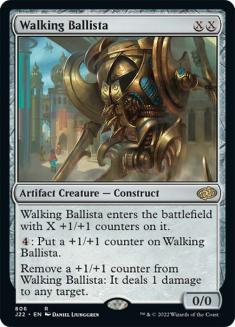
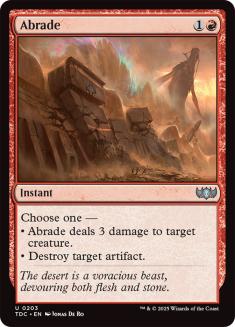




Through the Breach is a high variance card in this matchup. Its weakness to
Mausoleum Wanderer can be fatal, but its strength against Spell Queller can
be crucial. Breach into Emrakul is often the only line that can save you in
Game 1, but the attack is rarely lethal, and the annihilator trigger is at
its worst against their abundance of flash threats and Collected Company.
VS Burn
Out:



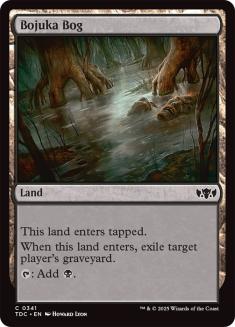

In:



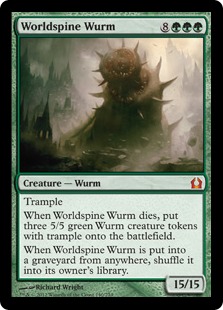

A weird dynamic occurs after sideboarding as Burn has access to high-impact
but conditional answers like Deflecting Palm or even Smash to Smithereens
which make it hard to judge how much danger you’re in — your opponent can
have four cards in hand to your six life but not actually have you dead. I
suspect the matchup would be harder if they simply presented their
maindeck, but since people love to bring in these cards, you must beware of
them. If you suspect Ensnaring Bridge, leave in Engineered Explosives or
find room for a Reclamation Sage.
VS Amulet Titan
Out:



In:



Against the true mirror, Negate and perhaps Spell Pierce are needed to
close the Breach.
VS Izzet Phoenix
Among the top decks of Modern, this is the matchup that most demands
flexible sideboarding.
In my finals match against friend and teammate, Tariq Patel, I knew I
didn’t have to worry about Blood Moon, that he had Spell Pierce and Dispel,
and that there we no cards like Monastery Swiftspear that force the game
into a race. I decided to cut the Breach package, focus on disrupting his
early threats, and let the rest of my deck do its thing. By contrast, my
semifinals opponent, Jake Mondello, had more countermagic that could
interact with Breach but also had Blood Moon and Path to Exile for the
Primeval Titan plan, so for Game 3 I would have considered sideboarding
back into Breach and trying to steal an early win. I had the full
information needed to make these plans, but in the early rounds of a
tournament you’ll have to make educated guesses. Do your homework and
notice what the subtle variations in lists mean. For example, Breeding Pool
suggests Eli Kassis’ list, which had two copies of Blood Moon but no
countermagic for Breach.
Regardless, you want Hornet Queen to handle Crackling Drake or parades of
Arclight Phoenixes and can cut Ghost Quarter or Teetering Peaks depending
on where Breach ends up.
There’s no better feeling in Magic than winning a tournament by taking the
whole room by surprise. I don’t expect this list to take over the format as
Amulet Bloom did, but I hope to see many of you receive the city’s
blessing.



